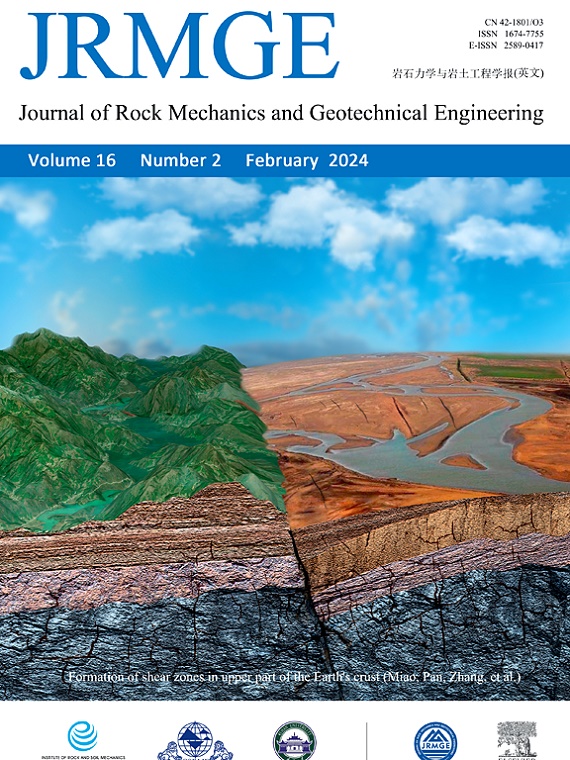A review of rock macro-indentation: Theories, experiments, simulations, and applications
IF 10.2
1区 工程技术
Q1 ENGINEERING, GEOLOGICAL
Journal of Rock Mechanics and Geotechnical Engineering
Pub Date : 2023-11-01
DOI:10.1016/j.jrmge.2023.07.022
引用次数: 0
Abstract
Rock macro-indentation plays a fundamental role in mechanical rock breaking for various rock engineering application, such as drilling, tunneling, cutting, and sawing. Over the past decades, extensive research has been conducted to understand the indentation mechanisms and responses through various approaches. This review aims to provide an overview of the current status and recent advancements in theories, experiments, numerical simulations, and applications of macro-indentation in rock engineering. It starts with elaborating on the mechanisms of macro-indentation, followed by a discussion of the merits and limitations of commonly used models. Influence factors and their effects on indentation test results are then summarized. Various numerical simulation methods for rock macro-indentation are highlighted, along with their advantages and disadvantages. Subsequently, the applications of indentation tests and indentation indices in characterizing rock properties are explored. It reveals that compression-tension, compression-shear, and composite models are widely employed in rock macro-indentation. While the compression-tension model is straightforward to use, it may overlook the anisotropic properties of rocks. On the other hand, the composite model provides a more comprehensive description of rock indentation but requires complex calculations. Additionally, factors, such as indentation rate, indenter geometry, rock type, specimen size, and confining pressure, can significantly influence the indentation results. Simulation methods for macro-indentation encompass continuous medium, discontinuous medium, and continuous-discontinuous medium methods, with selection based on their differences in principle. Furthermore, rock macro-indentation can be practically applied to mining engineering, tunneling engineering, and petroleum drilling engineering. Indentation indices serve as valuable tools for characterizing rock strength, brittleness, and drillability. This review sheds light on the development of rock macro-indentation and its extensive application in engineering practice. Specialists in the field can gain a comprehensive understanding of the indentation process and its potential in various rock engineering endeavors.岩石宏观压痕:理论、实验、模拟和应用综述
岩石宏观压痕在钻孔、隧道、切割、锯切等各种岩石工程应用中起着机械破岩的基础作用。在过去的几十年里,通过各种方法进行了广泛的研究,以了解压痕的机制和反应。本文综述了岩石工程中宏观压痕的理论、实验、数值模拟和应用的现状和最新进展。它首先详细阐述了宏观缩进的机制,然后讨论了常用模型的优点和局限性。总结了压痕试验的影响因素及其对压痕试验结果的影响。重点介绍了岩石宏观压痕的各种数值模拟方法及其优缺点。随后,探讨了压痕试验和压痕指标在岩石性质表征中的应用。结果表明,压拉、压剪和复合模型在岩石宏观压痕研究中得到了广泛应用。虽然压张模型使用简单,但它可能忽略了岩石的各向异性。另一方面,复合模型提供了更全面的岩石压痕描述,但需要复杂的计算。此外,压痕率、压痕几何形状、岩石类型、试样尺寸和围压等因素也会显著影响压痕结果。宏观压痕的模拟方法包括连续介质法、不连续介质法和连续-不连续介质法,根据它们的原理差异进行选择。此外,岩石宏观压痕可以实际应用于采矿工程、隧道工程和石油钻井工程。压痕指数是表征岩石强度、脆性和可钻性的重要工具。本文综述了岩石宏观压痕的发展及其在工程实践中的广泛应用。该领域的专家可以全面了解压痕过程及其在各种岩石工程中的潜力。
本文章由计算机程序翻译,如有差异,请以英文原文为准。
求助全文
约1分钟内获得全文
求助全文
来源期刊

Journal of Rock Mechanics and Geotechnical Engineering
Earth and Planetary Sciences-Geotechnical Engineering and Engineering Geology
CiteScore
11.60
自引率
6.80%
发文量
227
审稿时长
48 days
期刊介绍:
The Journal of Rock Mechanics and Geotechnical Engineering (JRMGE), overseen by the Institute of Rock and Soil Mechanics, Chinese Academy of Sciences, is dedicated to the latest advancements in rock mechanics and geotechnical engineering. It serves as a platform for global scholars to stay updated on developments in various related fields including soil mechanics, foundation engineering, civil engineering, mining engineering, hydraulic engineering, petroleum engineering, and engineering geology. With a focus on fostering international academic exchange, JRMGE acts as a conduit between theoretical advancements and practical applications. Topics covered include new theories, technologies, methods, experiences, in-situ and laboratory tests, developments, case studies, and timely reviews within the realm of rock mechanics and geotechnical engineering.
 求助内容:
求助内容: 应助结果提醒方式:
应助结果提醒方式:


